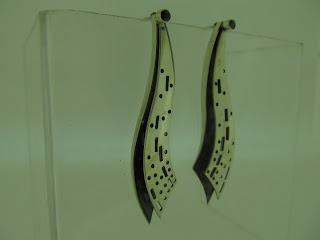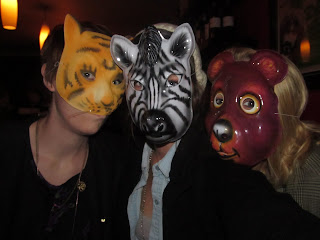whistleforthewind
Saturday, September 10, 2011
Tuesday, September 6, 2011
My jewellery
 |
| Morse Code Earings Sterling Silver, Blackened |
 |
| Morse Code Pendant Sterling Silver |
 |
| Blackboard and chalk pendant Sterling Silver, Black board, chalk |
 |
| 'Nappy Ring' Sterling Silver, Wood with resin inlay |
 |
| Cast letter ring Sterling Silver |
 |
| Flatband Sterling Silver |
 |
| Set of 3 hammered rings Sterling Silver |
Thursday, August 25, 2011
Case Study - Famke Koene
Famke has lived in Cape Town Cape Town Design Academy Eindhoven , Netherlands Holland Eindhoven , Netherlands
A chair Famke designed while at DAE
Famke does not have a specific set of philosophy ideals that she works by; however, there are certain aspects that she believes are necessary in a successful design. As can be seen in this vase set that she designed during her course in the Netherlands
Famke feels that jewellery design is a very personal form of design and often people seek jewellery that is visually beautiful and delicate. She, as a designer, tries to push these boundaries, forcing people to look past this and see jewellery in a different light. Her ideal is to create jewellery that is more bulky, surprising and off beat, which can still be viewed in the same light as more delicate pieces. Her dedication to this ideal can be seen in oversized watches that she restored.
Famke has not been in the jewellery industry for long enough in order to define her design style, but she is hoping to get a clearer idea of this in her forth year of studying. Famke loves using old or used materials in her designs, taking a variety of materials out of their original/ intended environment and re-using and re-working them into new jewellery, combining them with newer materials such as silver, gold or brass. She is greatly inspired by forms of geometry, element of nature, rust and decay as well as antique markets, imperfect and contrast that is found in the slightest detail.
The theme that she has chosen for her third year project can be closely linked to her many forms of inspiration. The theme is based on creating a greater appreciation and recognition for geometric structures that people most often view as cold, isolating and impersonal. Famke aims to do this by combining the geometric shapes with natural/ found objects, forcing people to view them in a different way and be able to notice the potential they may have. Bridging the gap between geometric and natural, and creating a successful marriage between the two.
The following three pieces form part of her ‘Found Objects’ range
Even after being in the jewellery design industry for such a short time, Famke realizes that it is a tough industry to break into and making a name for yourself as a designer will take up many hours and dedication. Famke encourages herself by focusing on the end result of each piece, and although restarting and frustration are part of the journey, she feels that a positive mindset will make life easier for any designer in a competing industry.
Already, Famke has commissioned pieces for numerous clients, all with positive feedback. While she has not set up a formal website of yet, she markets herself through the social website, Facebook, her blog that she frequently updates and through word of mouth. Once she becomes more established, Famke hopes to display her work at the annual Design Indaba as well as at popular designer markets.
This ring was commissioned by a friend of Famke’s
Famke is a hard working designer with the right mindset of a jeweler, a lot of great pieces can be expected from her in the near future.
Sunday, June 12, 2011
Dorothy Hogg
Dorothy Hogg
Dorothy Hogg was born in 1945. She is recognised around the world as a jeweller as well as a jewellery design teacher. From a young age, Dorothy has perused her talent and enjoyed a successful career as an artist.
Looking back on her career, she says, ‘"I think you’re a born artist. I couldn’t have learned it and I hope I never do because knowing more only encourages limitations".'’[1]
Since 1985, Dorothy has had the position as the head of the Glasgow School of Art as well as at the Royal College of Art. For 20 years she ran the department with full dedication while still maintaining her own creative practice. For many years, Dorothy has committed herself to setting up and managing exhibitions, she also represents educational boards at numerous institutions and promotes Scottish Jewellery across the world. Dorothy has participated in numerous collections and exhibitions that are published both in the United Kingdom
Dorothy was one of the first as well as one of the youngest artists to be invited into the new Museum Residency Programme at the Victoria Alfred Museum
In her lifetime as a renowned jeweller, Dorothy has been awarded with numerous prestigious awards such as an MBE for bringing recognition to the craft of jewellery design, which she won in 2001. But her most honoured award was gifted to her in 2005 when she was awarded the Brilliantly Brimingham Jewellery Award. This award is given to ‘the jeweller who has made the greatest contribution to the world of designer-maker jewellery.’[2]
Dorothy is of the third generation in her family who has successfully made manufacturing in metal objects her career. Dorothy prefers working in precious metals such as silver, as she finds that it is the most malleable and she enjoys the reflective qualities that silver obtains. In the 1970’s, she found herself experimenting in pieces made from flat sheets of silver to create hollow forms that appear to be heavier than what they actually are. And in the 1990’s, her forms of inspiration altered as she was deeply inspired by the idea of balance. At this stage of her life, Dorothy had to make time to balance her career, her new family as well as stick to her committed role as Head of Department. In the collection that she made from 1990 through to 1992, the pieces that were manufactured cleverly interact with the body’s (wearer’s) movement.
Dorothy is an artist known for using colour in her pieces not only for aesthetic value, but also to express and idea or symbolic meaning of the colour. In her most recent collection, ‘Artery Series’, she used other, cheaper materials such as felt and beads. Amongst the silver, she incorporated highlights of red to symbolise the blood that runs through the human veins. In a neckpiece that she was commissioned to do, she cleverly used red beads in a way that it seems they are embedded in the silver. From a technical aspect, it is clear to see that Dorothy is thorough when manufacturing and her patience and eye for detail are noticeably visible. For example, when Dorothy fixed the beads into place by manufacturing a basket structure by hand which was then attached to a spring, it is evident that her talent for this trade is manifest.
In recent years, Dorothy has intensely studied the use of literal and abstract forms and how they can be related back to the human body. ‘”The sources for these formal interactions spring from a fusion of the subconscious with my visual experience”, she says’[3]
Upon remembering her first visit to the V&A art gallery in 1960, she recalls how impressed she was as she felt she was entering such a special place for any artist to be able to display their work in. Since the 1960’s, she has managed to grasp the development of technology in modern day society and how it can be used as a medium to the craft of jewellery design. Dorothy has studied how this growth in technology compares to the development of historical technology and she has cleverly been able to apply her new-found knowledge to her own craft, jewellery design.
‘Dorothy says; “It will be useful to contextualise my own piece in the V&A collection and asses what is current in the jewellery design field at the moment through looking at the V&A collections.” She goes on to saying, “My investigation will extend to looking at objects from different cultures and making connections to my own visual language. However the approach to my own work is more intuitive than logical, I need time to see what ideas emerge when surrounded by such rich source material.” ‘[4]
The best way to understand the development of Dorothy’s work over the years is in her own words,’” My work changes echoing changes in me. As I have been exhibiting since the 1960s my work has developed over the decades. The underlying dialogue is with silver and ways of exploring the interaction of the body with jewellery. I engage interest by using intriguing geometry or subtle sound or by using light passing through transparent enamel to cast colour onto the skin or by making a piece to be touched or played with. I like the challenge of dealing with the wear ability of jewellery. All my pieces are extremely wearable even if they look as though they may not be at first glance. I enjoy the surprise when the wearer finds out their finger actually fits the strange geometry of a ring. My aesthetic is driven by my subconscious mind and reflects in an abstract way events and changes in my life. I am interested in the structure of the body, the way it moves and symbolic thoughts around this preoccupy my design process. The work I am currently engaged with is the ‘Artery Series’ where the pieces are constructed of sheet metal formed into tube. I am interested in how silver and other metals can be fabricated to create hollow forms that have visual weight without physical density.”’[5]
When reflecting on her design process, she says ‘“My aesthetic is driven by my subconscious mind and reflects in an abstract way events and changes in my life. The structure of the body, its movements and related conscious and unconscious symbolic thoughts preoccupy my design process.”
“Looking back over the decades of work it is surprising what is revealed about ones subconscious through the unlikely medium of jewellery.”’[6]
As a jewellery designer, I feel that I can relate to her design process as well as the every-day aspects that inspire her to make such wonderful pieces of jewellery.
Bibliography
Subscribe to:
Posts (Atom)








































